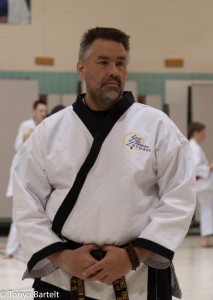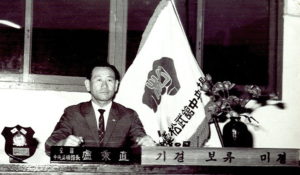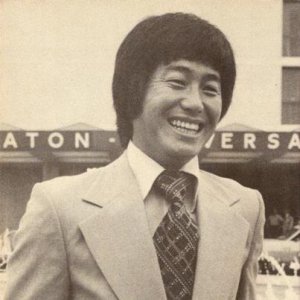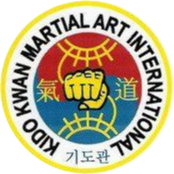CHUNG BONG
A Closer Look At True Korean Forms


Tae Kwon Do Song Moo Kwan was one of the original eight kwans recognized by the Korean government in 1945. Song Moo Kwan, 松武館 송무관 the Pine Tree School, was founded by Byung Jick Ro in Seoul shortly after WW II and was one of the kwans that followed in General Choi’s attempt to unify the Korean martial arts under the name Tae Kwon Do. Grandmaster Ro had trained with the Shotokan Karate 松濤館 founder, Gichin Funakoshi 船越 義珍. When Song Moo Kwan was first taught, Grandmaster Ro used the forms that were taught to him by Funakoshi. (太極初段), Heian shodan (平安初段), Heian nidan (平安二段), Heian sandan (平安三段), Heian yondan(平安四段), Heian godan (平安五段), Bassai dai (披塞大), Jion (慈恩), Enpi (燕飛), Kanku dai (観空大), Hangetsu (半月), Jitte (十手), Gankaku (岩鶴), Tekki shodan (鉄騎初段),Tekki nidan (鉄騎二段), Tekki sandan (鉄騎三段), Nijūshiho (二十四步), Chinte (珍手), Sōchin (壯鎭), Meikyō/Rōhai (明鏡), Unsu (雲手), Bassai shō (披塞小), Kankū shō (観空小), Wankan (王冠), Gojūshiho shō (五十四歩小), Gojūshiho dai (五十四歩大), and Ji’in (慈陰).
When the Kwans began to appear, each had its own philosophy and teachings. One concept that made Song Moo Kwan different from the others is that practitioners felt many of the techniques were being taught incorrectly because the hips were not involved enough while executing the techniques. After the unification of the kwans, Grandmaster Ro started to teach the poomse that had been developed by General Choi. There were used, and still are by some Song Moo Kwan instructors, until 1974 when a student of Grandmaster Ro designed the Chung Bong poomse. Master Jay Hyon had come to Minneapolis, MN, in the early 1960’s and established the Karate Center. Master Hyon developed the Chung Bong poomse, which he introduced to his students, and replaced the poomse of General Choi. It is still unclear if these poomse have become the “official” poomse of Song Moo Kwan; but today the Grandmaster’s son, Hee Sang Ro, teaches them

in the dojang. These poomse have become a very valuable training method for many students. It is unfortunate Master Hyon only developed seven poomse before his retirement.
The Chung Bong poomse are widely different from the other poomse used by Tae Kwon Do schools for several reasons. These are 1) the number of and percentage of kicks, 2) the type of kicks used, 3) introduction of new techniques, and 4) the variation in stances. Chung Bong poomse have a large number of kicks in each pattern while keeping the number of movements similar to those of other poomse patterns.
The following chart demonstrates this information.
Chung Bong Forms # of movement’s # of kicks % of kicks
The Pyung-An/Hei-An sets have only 31 kicks through 568 movements (5.29%) in 15 poomse; the Chon-ji set has 94 kicks though 736 movements (12.77%) in 20 poomse; the Taeguek set contains 45 kicks in 8 Poomse; and the PalGwe set (with Ki-Cho) has 25 kicks through 214 movements (11.68%) in 9 poomse (statistics taken from “Korean Forms” by Rick Clark in TKDT, November 1995). In comparison, the Chung Bong poomse average the same number of movements through seven patterns but contains a greater number of kicks per pattern for a larger over all percentage of kicks used.
The v poomse are unique in that they introduce techniques sooner than their counterparts from other kwans. The time at which a student is required to learn a specific technique varies from one set of poomse to another. The Chung Bong poomse challenge a student from the start by requiring the three basic kicks be learned for the first poomse. This differs from the Taeguek poomse, which has only a front kick in the first poomse and does not introduce the side kick until the fourth and the round kick until the sixth. This slower progression can also be seen in the Palgwe poomse that introduces a front kick in the fifth poomse and the side kick in the seventh. The Palgwe poomse do not use a round kick in their formal training set. Also, General Choi’s forms do not use a front kick until the third form; the side kick until the fourth; and the round kick until the eighth.
In Chung Bong poomse, the kicks are not only introduced quickly, but there are variations used. This can be seen in Chung Bong one by having front thrust kicks done in the beginning of the pattern and front snap kicks done at the end. Although there are variations, the forms keep with the belief of using the hips more effectively to throw the kicks. This includes using only a thrusting side kick within the poomse. The reasoning behind this is that if a snapping side kick would be used, a round (or roundhouse) kick would be more effective. This is not to say that there are no similarities in the movements within the Chung Bong set to those in other poomse sets. In fact, they contain the long and deep stances as seen in the Palgwe poomse and have the ability to be adapted for combat as easily as any of the poomse sets that are used today, including the Taeguek poomse used by the World Tae Kwon Do Federation (WTF). The stances help in the physical development of the student and in teaching how the hips become involved in techniques.
The Chung Bong poomse, also, use “intermediate” stances for moving into a follow up technique. Variation in stances make these poomse a challenge to the student. Not only are many different stances used but some are unusual and modified. These modified stances allow the students to see how different strategies can be used to help develop more flexibility in their movements. This flexibility allows each student to adapt techniques to compliment their strengths. Modified stances are often used as “intermediate” positions for moving from technique to technique. A “half-front” stance is used in Chung Bong Four to help the student move from a defensive posture to an offensive one. This poomse has the student in a back stance executing a down block, then shifting forward to a half front stance while performing a ridge hand with the lead arm and followed by a rear leg side kick then setting down into a front stance doing a reverse punch.
Another example of a modified stance can be found in Chung Bong Seven. The use of a stance similar to the “archer’s stance” as found in some Chinese martial arts, is used to draw an opponent closer causing an over extension of the attacking technique and loss of proper positioning without the student moving beyond his range of effectiveness. One of the other similarities to the poomse used by different kwans is combat adaptability of the techniques. Many of the techniques have been put together in such a way that they allow for very effective combinations when applied to combat and sparring. The Taeguek and PalGwe poomse have this quality but as stated before, are slower at introducing techniques to the student. The Chung Bong poomse present effective combinations from the beginning with Chung Bong One. Not only are the front kick/lunge punch combinations (which can be translated into front/jabs) at the start of the poomse, but the rear leg round kick/lead arm extension/reverse punch (as described earlier with the modified stances), used later in the poomse, is easily changed to a rear leg round kick/jab/reverse punch. This concept can be found all through the Chung Bong poomse while using a variety of techniques in combination.
Poomse are one of the most important parts of the Tae Kwon Do students’ training. It allows the student to learn and study techniques; to develop a greater understanding of them; and demonstrates the best way in which to apply them. All serious forms training will benefit the student no matter which poomse set is learned. A student who understands the purpose of poomse training will be able to adapt the techniques to combat/sparring situations and the strategies to conflicts found in everyday life. Instructors who know their poomse will be able to help their students through any difficulties that they may encounter. Often Tae Kwon Do students have not learned the origins of their kwans and have no knowledge of its history other than General Choi’s advancements—if that. This seems strange when other arts such as Aikido tell of their origins and never forget the founder, O Sensei, when material and techniques are passed on to the students. It seems that Tae Kwon Do has forgotten its inception and evolution. The martial arts can help people to grow and learn about themselves but if histories and traditions are not taught, students will not develop the respect that has been passed from generation to generation.
Without tradition and history, a martial art is only a collection of techniques. The evolution of Tae Kwon Do will continue throughout its existence. What direction it will go is largely determined by how well the students have developed as generations pass. The development of new poomse sets will also occur. The quality of these new poomse will be dependant upon the depth of understanding the student has; the amount of effort put into developing them; the connection to the history and evolution; and current environmental factors. The factors that have lead to the creation of poomse now used will change, but it seems that may be the Chung Bong poomse is the most advanced form to date—using ideas from the past and incorporating modern concepts.
![]()

Average Rating